When I heard about the grisly discoveries unearthed at animal tourism attraction Tiger Temple, I felt physically sick; it was only a few months earlier I had spotted the temple on the way to another tourist attraction. I remember feeling uneasy as I passed the gates. What exactly was going on behind those doors?
Rewind a few months prior and my boyfriend Tim and I were sitting at my dining table planning our trip to South East Asia. Whilst I had already done a bit of travelling, neither of us really knew what we were doing when it came to backpacking. Armed with a guidebook and Google, we made a list of things we wanted to do during our trip.
Along with its Full Moon parties and Muay Thai fights, Thailand is also famous for its animal tourism trade. This industry draws in thousands of visitors every year and I will confess that I was no different. Elephant riding was on my bucket list and I had decided here was the place to do it. After expressing this desire to Tim, my expectation was that he would share my excitement. Instead, he looked enquiringly at me, “Is that not cruel?”
This question knocked me slightly. Was it cruel? To be honest it wasn’t really something I had thought about. Elephants are strong animals and I couldn’t see how they would suffer from carrying a couple of humans on their backs. I knew plenty of people, including animal lovers, that had ridden on elephants and I’m positive they wouldn’t want to partake in a cruel practice. Despite this initial thought, my mind continued to nag me. Elephants don’t give rides in the wild, isn’t that enough to raise some moral questions?
Sanctuary not Suffering
With doubt planted firmly in my head, we decided to do some research into the Thai animal tourism business. The treatment of animals is something which differs hugely between the East and the West: owing to the lack of animal protection laws in the East, it is much more common to observe animals being exploited for financial gain.
A Google search produced images of elephants wearing bulky metal saddles strapped to their backs; umbrellas and tourists planted on top. When I had considered an elephant ride, I definitely hadn’t pictured it like this. I started to look into elephant riding without a saddle; more commonly known as bareback riding. Whilst this appears to be preferable to the use of cumbersome chairs, opinions differ on the effect this has on the elephant. From what I read, there is a lot of evidence to support the claim that elephants do not have strong enough spines to regularly hold the weight of humans. There is also evidence that suggests that to train the elephants to give rides, babies are ripped from their mothers at a young age and savagely beaten. This will crush the elephants’ spirit and make them easier to control. That decided it for me – no elephant rides.
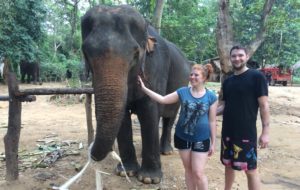
I was quickly giving up on my dream to ever get close to an elephant when I stumbled upon the Elephant Nature Park website. This project seeks to provide sanctuary for rescued elephants, retiring them from human exploitation. The park has no riding or shows but instead, promotes a different kind of animal tourism. Visitors take part in caring for the elephants by means of feeding, observing, washing, and trekking alongside them. Completely bowled over by this innovative scheme, Tim booked us in.
We were some of the first visitors to Elephant Haven, having only been established by Elephant Nature Park a couple of months previous. Our guide explained that the all of the elephants used to be forced to perform in shows and give rides. The project staff approached the owner of a local elephant show and proposed he pioneered a new care orientated scheme in Kanchanaburi; thus, Elephant Haven was born. This new eco-friendly experience would still generate money from the elephants but also offer them a fairer and more fulfilled life. The project aims to educate people about the benefits of this form of animal tourism and encourage them to change their attitudes towards the treatment of animals.
While each elephant at Elephant Haven had a trained mahout to ensure our safety, no physical force or coercion was used. We were able to get astonishingly close to the elephants as they wandered through the jungle with us trekking alongside. During the course of the day, we also watched the elephants playing in a mud bath and had the opportunity to wash them in a river. The elephants appeared to be completely at ease and were never forced into anything. The whole experience was incredible and I felt truly privileged to have been a part of it.
Sadly, not all elephants are as lucky as the ones at Elephant Haven. While we were staying in Ayutthaya, we saw elephants giving tourists rides and wearing heavy saddles. At the stable, elephants were kept chained up with next to no food and water. As the mahouts rode them around town they used ice picks to prod and beat them until they responded appropriately. This blatant display of animal abuse was harrowing to watch and upset me deeply. I was so grateful that we had visited an attraction that promoted elephant wellbeing.
Thailand’s Tiger Secrets
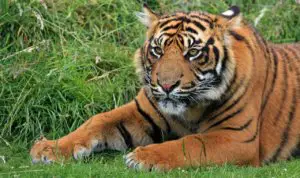 My research into the elephant trade in Thailand had sparked an interest and I continued to look further into animal tourism. I found several articles that explored Thailand’s use of tigers to attract tourists which didn’t make for easy reading. At this point, few reports of cruelty at these places had been proven but rumours floated all over the web. I read claims that tiger cubs were fed all day by tourists until they were sick and larger animals were declawed and permanently drugged to enable tourists to get as close as possible for photos. There were many claims about Tiger Temple in particular, with speculation that the monks in charge were involved in trafficking the tigers to nearby countries where their parts are believed to have medicinal properties. Regardless of the validity of these claims, it can be seen from simply looking at photos of tourists with tigers that this isn’t an ideal environment for these big cats. The tigers are kept chained in small concrete cages that bear no resemblance to their natural habitat.
My research into the elephant trade in Thailand had sparked an interest and I continued to look further into animal tourism. I found several articles that explored Thailand’s use of tigers to attract tourists which didn’t make for easy reading. At this point, few reports of cruelty at these places had been proven but rumours floated all over the web. I read claims that tiger cubs were fed all day by tourists until they were sick and larger animals were declawed and permanently drugged to enable tourists to get as close as possible for photos. There were many claims about Tiger Temple in particular, with speculation that the monks in charge were involved in trafficking the tigers to nearby countries where their parts are believed to have medicinal properties. Regardless of the validity of these claims, it can be seen from simply looking at photos of tourists with tigers that this isn’t an ideal environment for these big cats. The tigers are kept chained in small concrete cages that bear no resemblance to their natural habitat.
Photo Props and Monkeys
A rising problem in Thailand is the animal photo prop trade. In tourist hotspots such as Bangkok and Phuket, locals line the streets holding cute animals and charge visitors to have their photo taken with them. Most commonly you will see eagles, gibbons and slow lorises. These animals are often obtained illegally from the black market and poachers usually end up killing the mother of the baby animals in order to remove them from the wild. Many mammals are declawed and even have their teeth removed to stop them from injuring their new owners. The ‘No Photos, Please!’ campaign has made huge progress in reaching the masses and educating people about the brutality behind the photo props industry.
I also found information about various monkey shows all over the country. In these shows, monkeys are forced to dance for the crowd, an unnatural practice that is encouraged at a very early age. Many of these monkeys are removed from the wild as babies and reared by humans. When not performing for tourists, monkeys are commonly kept in chains.
Times are changing…
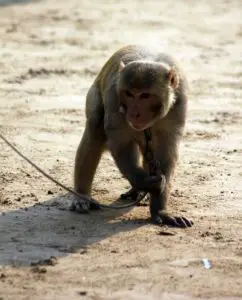 After reading about Tiger Temple I can’t say I was shocked when I heard they had discovered dead tiger cubs in the freezer. It was hardly difficult to find people making allegations against Tiger Temple – evidence flooded the internet. Although there’s no doubt in my mind that the closure of Tiger Temple was much too late, this is hugely positive progress in the transformation of Thailand’s animal tourism trade.
After reading about Tiger Temple I can’t say I was shocked when I heard they had discovered dead tiger cubs in the freezer. It was hardly difficult to find people making allegations against Tiger Temple – evidence flooded the internet. Although there’s no doubt in my mind that the closure of Tiger Temple was much too late, this is hugely positive progress in the transformation of Thailand’s animal tourism trade.
Visitors to these kinds of attractions are inadvertently perpetuating this cycle of exploitation and abuse. However, in my opinion it is too simplistic to just blame the tourists. As someone who loves animals, I was nearly one of the people queuing up for elephant rides. I doubt there’s a single person who would want to see these animals suffer and continuing to raise awareness is paramount to revolutionising the industry in the future.
As a responsible traveller, you can do your bit to put an end to the cruelty that thrives in Thailand’s animal tourism trade:
- Never pay to have your photo taken with an animal. Creating a demand for this allows poachers to continue to kill exotic wildlife.
- Always do your research when it comes to riding animals. Check out this post on camel riding!
- Focus on visiting animal projects that have care as their core aim.
- Use Tripadvisor to investigate places of interest and share your own opinions to educate other potential visitors.
- Speak to other travellers and listen to their stories.
- Don’t let tour companies or tuk-tuk drivers bully you into supporting an attraction you think is cruel.
It has been a long time coming but it appears that things are finally taking a step in the right direction in the Thai animal tourism industry. The closure of Tiger Temple and the move to care orientated projects such as Elephant Haven are massive leaps to building a fairer environment for both animals and tourists alike. If all of us refuse to invest money into animal exploitation, there will be no choice but for the focus of animal attractions to alter. Sadly, this is not something that will happen overnight but times are changing, something that can only be positive.
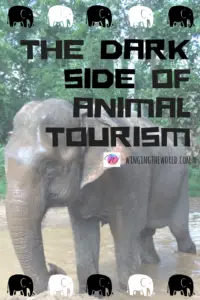 Love it? Pin it! 🙂
Love it? Pin it! 🙂

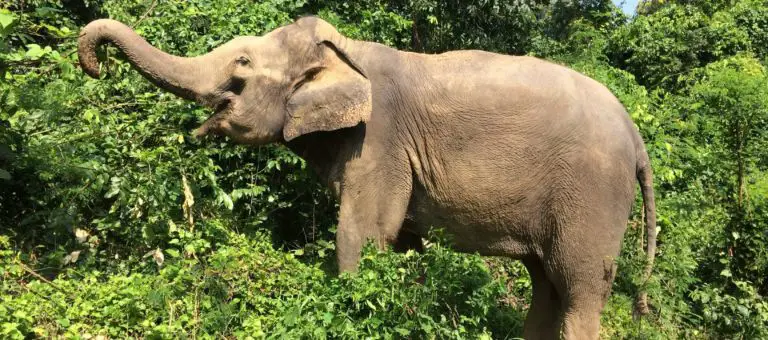
Riding Elephants is such a double edged sword today. Makes one feel guilty, yet it may be the only way of raising funds to protect them.
Cheers Sharon…
There is definitely a massive problem with exploitation of elephants at the moment. Luckily, there are some great organisations popping up, which mean tourists can interact with these gentle giants in a guilt free way. Save the Elephant Foundation is doing amazing work when it comes to the protection of asian elephants and the education of visitors!